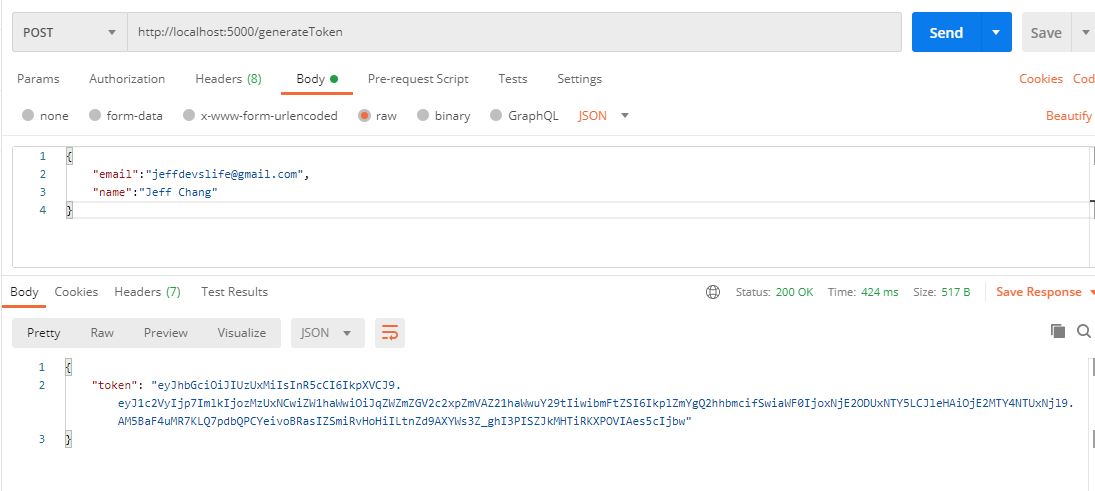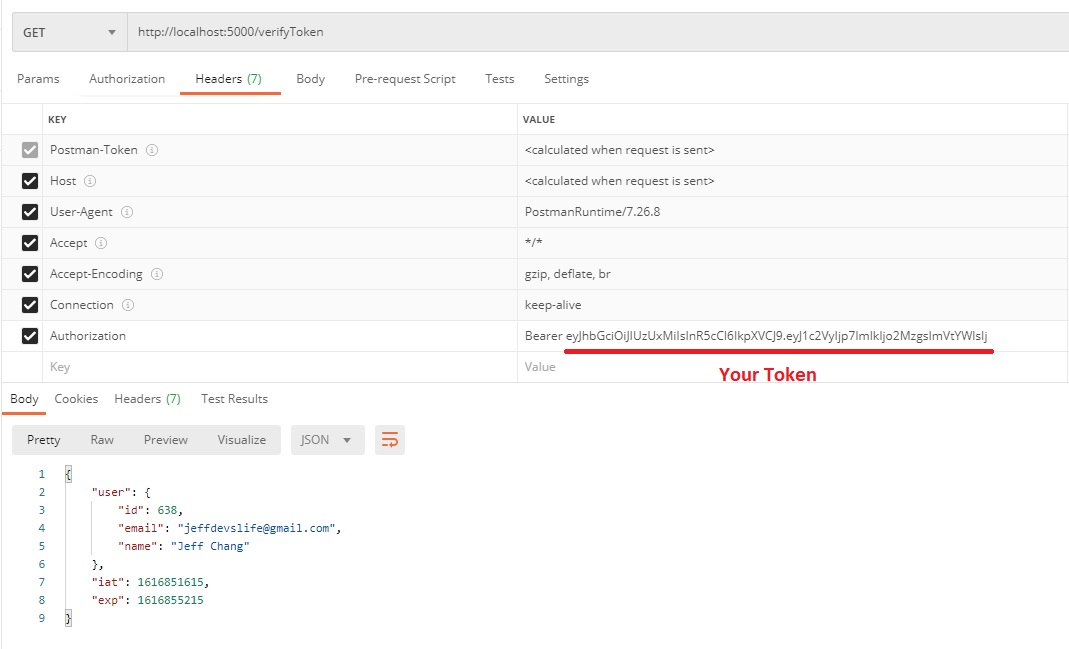In this article, we will use Postman for testing the APIs and covering:
First of all, please make sure you’ve installed these 2 packages:
jsonwebtoken and express
Generate a JWT token
Let’s include the packages we just installed and start our server at PORT 5000
const express = require('express');
const jwt = require('jsonwebtoken');
const app = express();
app.use(express.json()); // middleware to read json body
app.listen(process.env.PORT || 5000, () => console.log('server is running at port 5000'))Now, let’s write an API that will generate a JWT token which will encode the email address and name from request payload.
app.post("/generateToken", async (req, res) => {
try {
//custom JWT claims
const jwtClaimsObject = {
user: {
id: Math.floor((Math.random() * 99999) + 1),
email: req.body.email, //email from request payload
name: req.body.name //name from request payload
}
}
const token = jwt.sign(jwtClaimsObject, "< your secret value >", { algorithm: "HS512", expiresIn: '1h', })
res.json({ token: token })
} catch (error) {
console.error(error.message);
res.status(500).json({ error: 'error generating token' })
}
})Explanation
- Create A POST http method API with endpoint http://localhost:5000/generateToken to generate JWT
- Create a custom JWT Claims which stores our information
- In this case we assign random number into user id which normally we wont do in this way. The real case will be putting the unique number/ id (from database) into the user id
- Then, we can use the
jwt.signmethod which takes in at least 3 parameters which are our jwt claim object, our serect/ private key (used to verify and decode our token) and other options like algorithm, issuer, expires time and etc- There are some algorithm references you can refer below:
- HS256: HMAC using SHA-256 hash algorithm (default)
- HS384: HMAC using SHA-384 hash algorithm
- HS512: HMAC using SHA-512 hash algorithm
- RS256: RSASSA using SHA-256 hash algorithm
- RS384: RSASSA using SHA-384 hash algorithm
- RS512: RSASSA using SHA-512 hash algorithm
- ES256: ECDSA using P-256 curve and SHA-256 hash algorithm
- ES384: ECDSA using P-384 curve and SHA-384 hash algorithm
- ES512: ECDSA using P-521 curve and SHA-512 hash algorithm
- none: No digital signature or MAC value included
- For the expiry time it can be expressed into string or number such as 60, “2 days”, “10h”, “7d”. Expiry Reference
- There are some algorithm references you can refer below:
- Response back the jwt to our client so that we can attach them in the request header for future API calls
Result
Verify a JWT token
Let’s write an API that will verify and decode JWT token.
app.get("/verifyToken", async (req, res) => {
try {
const authHeader = req.header("Authorization");
//Return if missing header/ wrong Authorization header format
if (!authHeader || !authHeader.startsWith("Bearer ")) {
res.status(403).json({ error: "Forbidden Access" })
return
}
const token = authHeader.substring(7, authHeader.length);
if (token === "") {
res.status(403).json({ error: "Forbidden Access" })
return
}
const decodeClaims = jwt.verify(token, "< your secret value >")
res.json(decodeClaims)
} catch (error) {
console.error(error.message);
res.status(500).json({ error: 'errorr' })
}
})Explanation
- Create A GET http method API with endpoint http://localhost:5000/verifyToken to verify JWT
- For best practice, we will attach our JWT together with the Bearer inside Authorization header Refer here for more info
- This is to follow the pattern of
Authorization: <type> <credentials>
- This is to follow the pattern of
- Use jwt.verify method to decode the JWT claims by providing the correct secret/ private key
- Return the decoded jwt claims to our client
Result
Summary
- Never include your credentials info like password in your JWT claims as you can get the user Id can check password from database
- You should always save your secret/ private key into a safety place like process.env which is the file under gitignore control
- JWT is very useful to act as a API middleware to determined whether the user/ client is authorize to access the endpoint


